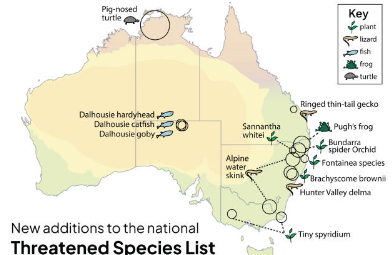Australia Adds 13 Species to Threatened List Amid Crisis
Australia has added 13 new species to its threatened list. This has led to urgent calls to reform the country’s environmental laws. Among the newly listed species are the vulnerable pig-nosed turtle, the critically endangered Dalhousie catfish, and the Coffs Harbour Fontainea. These species face extinction risks due to habitat destruction and climate change.
Threatened Species in Numbers
With the new additions, the total number of threatened species in Australia is now 2,224. Many of these species have been severely affected by extreme weather events, like the devastating 2019-20 bushfires.
Causes of Threats
The primary threats to these species are:
- Habitat destruction: Caused by human activities such as mining and agriculture. For example, over 90% of the known habitat of the Hunter Valley delma lizard has been impacted by open-cut mining.
- Climate change: Leading to more extreme weather events and changing habitats.
Government Response
The Albanese government has proposed new environmental laws, including Establishing a national Environmental Protection Authority (EPA) and Creating Environment Information Australia. However, there are significant delays in updating existing nature laws.
Concerns Over Disease
New threats, like avian influenza (specifically the H5 variant), are worrying conservationists because they could further endanger vulnerable bird populations. The government is pushing for a coordinated approach to tackle potential wildlife diseases. The Environment Minister has stressed the need for stronger legal protections. Current initiatives include combating feral animals and invasive weeds and establishing a more effective regulatory body to enforce conservation measures.
About Threatened Species
Threatened species are those at risk of extinction. They are categorized as vulnerable, endangered, or critically endangered. Globally, over 28,000 species face extinction, mainly due to Habitat loss, Climate change and Poaching. Amphibians are particularly at risk, with over 40% threatened. The IUCN Red List is the global standard for assessing the status of species. Coral reefs, which are vital marine ecosystems, support diverse life but are increasingly endangered.
Month: Current Affairs - August, 2024
Category: International / World Current Affairs






